Exploring the Impact of Crowdfunding on Startups: A Literature Review
VerifiedAdded on 2023/06/08
|37
|9064
|297
Literature Review
AI Summary
This literature review examines the impact of crowdfunding on startups, drawing upon various authors' perspectives and opinions. It explores factors affecting crowdfunding, including advantages and disadvantages, analyzed through theories like Financial Intermediation Theory, Transaction Cost Theory, and Resource-Based View Theory. Different types of crowdfunding, such as rewards-based, equity-based, and debt-based, are discussed. The review identifies and discusses limitations of the articles used, aiming to provide a comprehensive understanding of crowdfunding's influence on startups. The core objective is to determine the extent to which crowdfunding impacts new ventures, offering a critical analysis of existing literature.
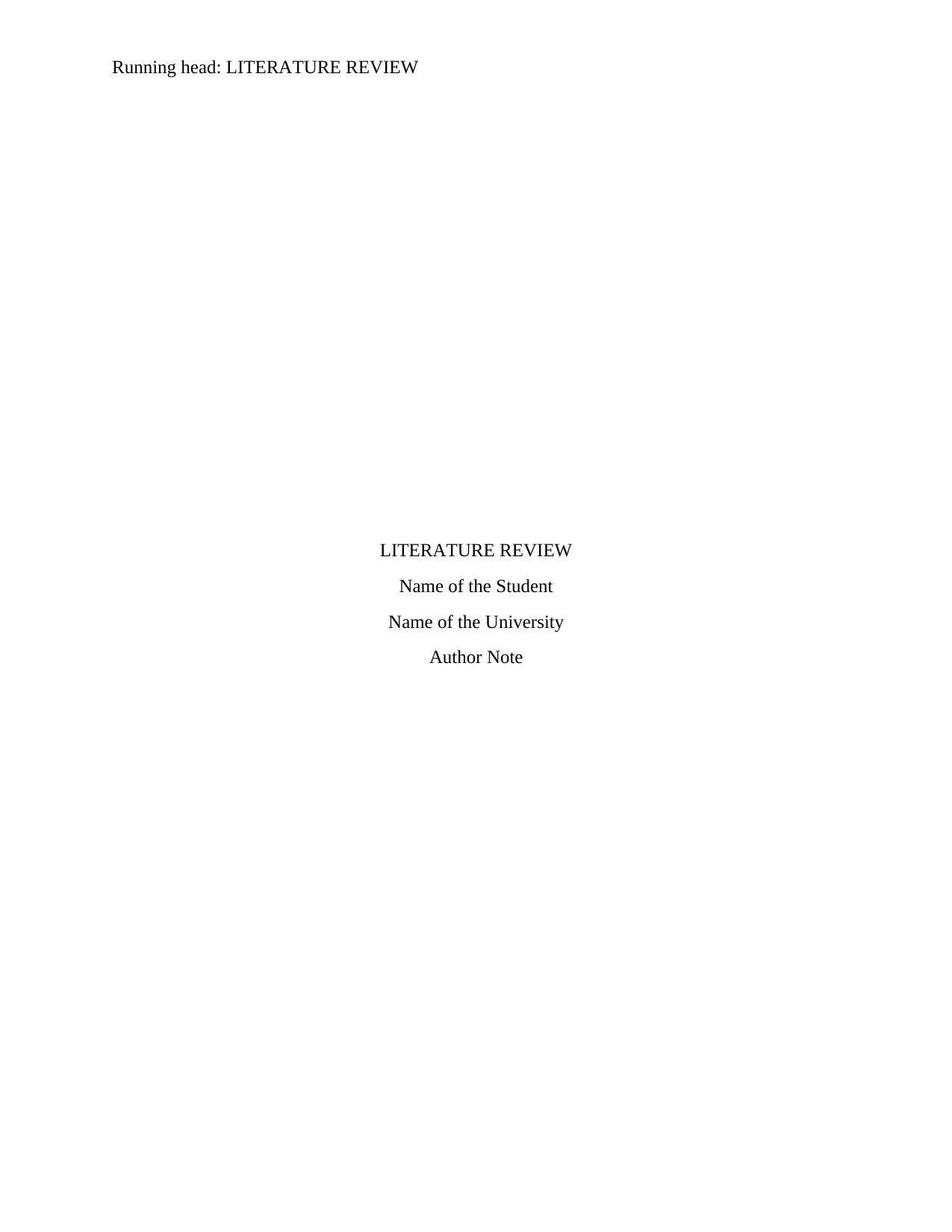
Running head: LITERATURE REVIEW
LITERATURE REVIEW
Name of the Student
Name of the University
Author Note
LITERATURE REVIEW
Name of the Student
Name of the University
Author Note
Paraphrase This Document
Need a fresh take? Get an instant paraphrase of this document with our AI Paraphraser

1LITERATURE REVIEW
Literature Review
Topic: Impact of crowdfunding in startups
Introduction
Crowd funding is one of the major aspects in initiating startups due to the fact that this
strategy is one of the most effective strategies for the small and medium startups. However, there
are different and diverse views as well as opinions being given by different authors regarding the
impact of Crowd funding in startups (Kirby and Worner 2014). These views and opinions are
varied in nature and range from positive impact to negative impact. However, it should also be
noted that in order to have the argumentative approach in discussing about the impact of Crowd
funding in startup, there are number of factors being identified from the perspective of both the
variable, Crowd funding and startups. In this section, literature review will be done based on the
opinions given by different authors in respect to the identified factors.
In this section, the major factors affecting along with the advantages and disadvantages of
Crowd funding for startups will also be discussed. These aspects will also be critically analyzed
on basis of different views of the authors. Conceptual framework will also be designed in
accordance to the identified theories. This will further help to understand the impacts of different
factors of Crowd funding on startups. Furthermore, in this section, the limitations of the articles
to be used will be also be identified and discussed. Identification of these limitations will help to
have the fair idea about the shortcomings of the articles or to the views of the authors. This
section will also discuss about the limitations of doing the literature review. The core objective
of doing the literature review is to identify the extent to which the concept of Crowd funding will
have impact on the startups.
Literature Review
Topic: Impact of crowdfunding in startups
Introduction
Crowd funding is one of the major aspects in initiating startups due to the fact that this
strategy is one of the most effective strategies for the small and medium startups. However, there
are different and diverse views as well as opinions being given by different authors regarding the
impact of Crowd funding in startups (Kirby and Worner 2014). These views and opinions are
varied in nature and range from positive impact to negative impact. However, it should also be
noted that in order to have the argumentative approach in discussing about the impact of Crowd
funding in startup, there are number of factors being identified from the perspective of both the
variable, Crowd funding and startups. In this section, literature review will be done based on the
opinions given by different authors in respect to the identified factors.
In this section, the major factors affecting along with the advantages and disadvantages of
Crowd funding for startups will also be discussed. These aspects will also be critically analyzed
on basis of different views of the authors. Conceptual framework will also be designed in
accordance to the identified theories. This will further help to understand the impacts of different
factors of Crowd funding on startups. Furthermore, in this section, the limitations of the articles
to be used will be also be identified and discussed. Identification of these limitations will help to
have the fair idea about the shortcomings of the articles or to the views of the authors. This
section will also discuss about the limitations of doing the literature review. The core objective
of doing the literature review is to identify the extent to which the concept of Crowd funding will
have impact on the startups.
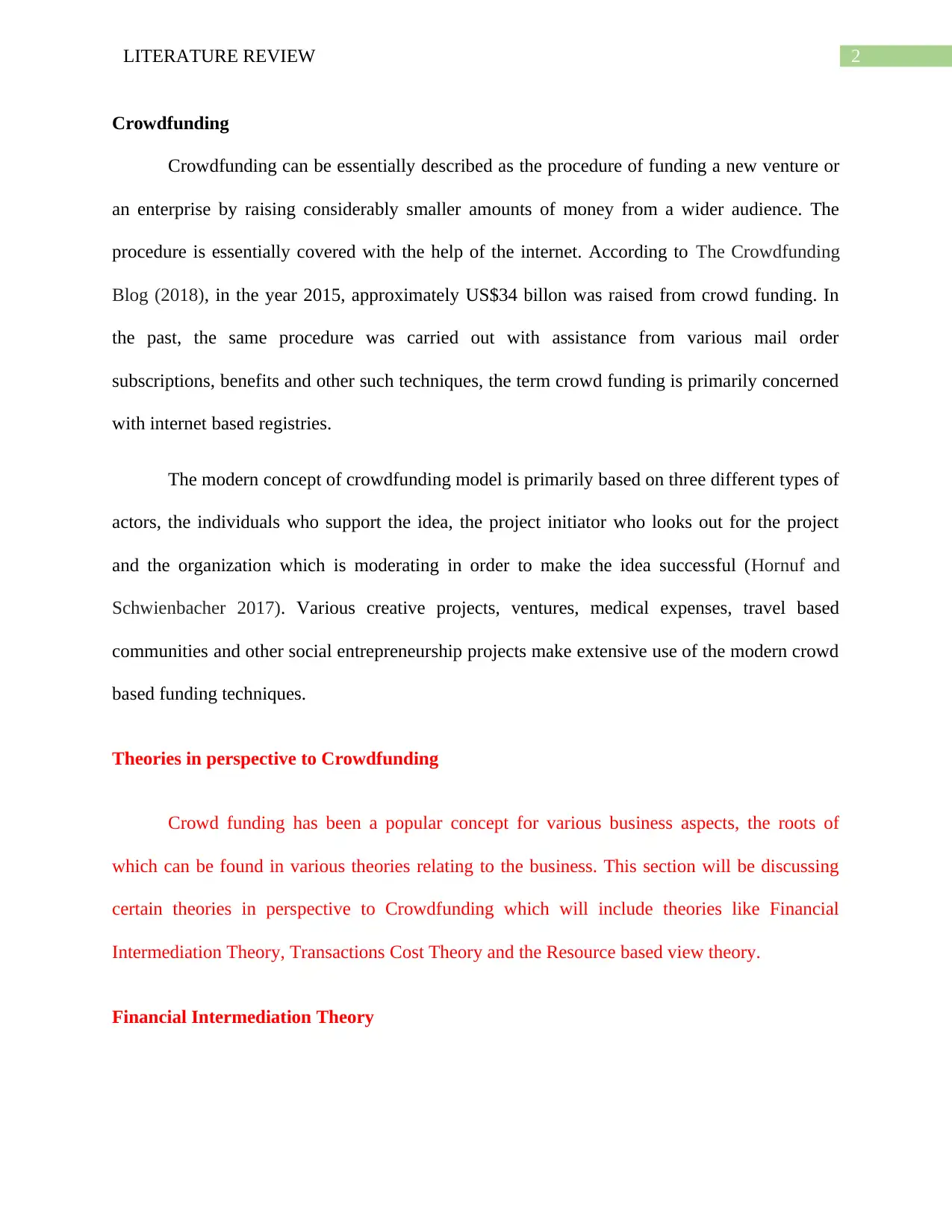
2LITERATURE REVIEW
Crowdfunding
Crowdfunding can be essentially described as the procedure of funding a new venture or
an enterprise by raising considerably smaller amounts of money from a wider audience. The
procedure is essentially covered with the help of the internet. According to The Crowdfunding
Blog (2018), in the year 2015, approximately US$34 billon was raised from crowd funding. In
the past, the same procedure was carried out with assistance from various mail order
subscriptions, benefits and other such techniques, the term crowd funding is primarily concerned
with internet based registries.
The modern concept of crowdfunding model is primarily based on three different types of
actors, the individuals who support the idea, the project initiator who looks out for the project
and the organization which is moderating in order to make the idea successful (Hornuf and
Schwienbacher 2017). Various creative projects, ventures, medical expenses, travel based
communities and other social entrepreneurship projects make extensive use of the modern crowd
based funding techniques.
Theories in perspective to Crowdfunding
Crowd funding has been a popular concept for various business aspects, the roots of
which can be found in various theories relating to the business. This section will be discussing
certain theories in perspective to Crowdfunding which will include theories like Financial
Intermediation Theory, Transactions Cost Theory and the Resource based view theory.
Financial Intermediation Theory
Crowdfunding
Crowdfunding can be essentially described as the procedure of funding a new venture or
an enterprise by raising considerably smaller amounts of money from a wider audience. The
procedure is essentially covered with the help of the internet. According to The Crowdfunding
Blog (2018), in the year 2015, approximately US$34 billon was raised from crowd funding. In
the past, the same procedure was carried out with assistance from various mail order
subscriptions, benefits and other such techniques, the term crowd funding is primarily concerned
with internet based registries.
The modern concept of crowdfunding model is primarily based on three different types of
actors, the individuals who support the idea, the project initiator who looks out for the project
and the organization which is moderating in order to make the idea successful (Hornuf and
Schwienbacher 2017). Various creative projects, ventures, medical expenses, travel based
communities and other social entrepreneurship projects make extensive use of the modern crowd
based funding techniques.
Theories in perspective to Crowdfunding
Crowd funding has been a popular concept for various business aspects, the roots of
which can be found in various theories relating to the business. This section will be discussing
certain theories in perspective to Crowdfunding which will include theories like Financial
Intermediation Theory, Transactions Cost Theory and the Resource based view theory.
Financial Intermediation Theory
⊘ This is a preview!⊘
Do you want full access?
Subscribe today to unlock all pages.

Trusted by 1+ million students worldwide
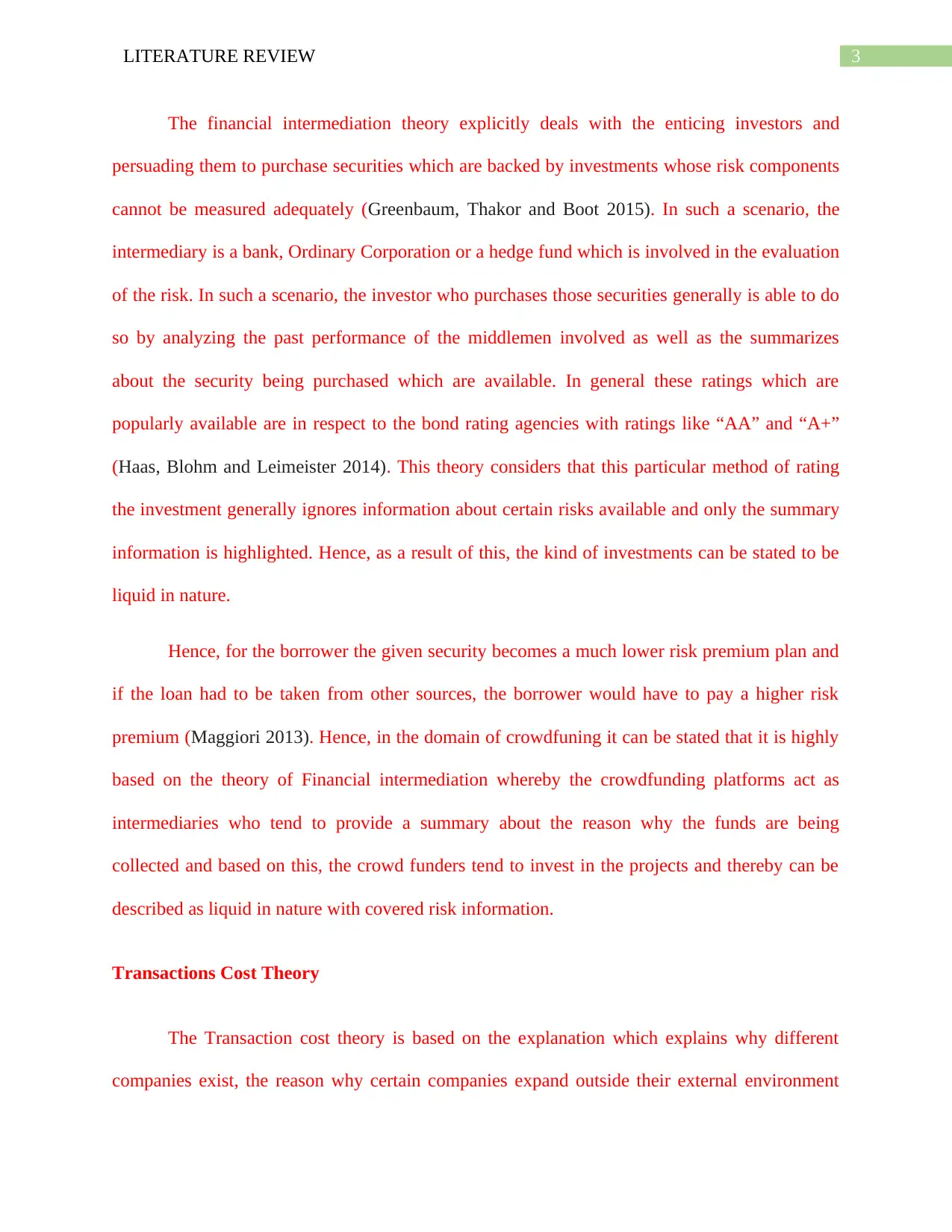
3LITERATURE REVIEW
The financial intermediation theory explicitly deals with the enticing investors and
persuading them to purchase securities which are backed by investments whose risk components
cannot be measured adequately (Greenbaum, Thakor and Boot 2015). In such a scenario, the
intermediary is a bank, Ordinary Corporation or a hedge fund which is involved in the evaluation
of the risk. In such a scenario, the investor who purchases those securities generally is able to do
so by analyzing the past performance of the middlemen involved as well as the summarizes
about the security being purchased which are available. In general these ratings which are
popularly available are in respect to the bond rating agencies with ratings like “AA” and “A+”
(Haas, Blohm and Leimeister 2014). This theory considers that this particular method of rating
the investment generally ignores information about certain risks available and only the summary
information is highlighted. Hence, as a result of this, the kind of investments can be stated to be
liquid in nature.
Hence, for the borrower the given security becomes a much lower risk premium plan and
if the loan had to be taken from other sources, the borrower would have to pay a higher risk
premium (Maggiori 2013). Hence, in the domain of crowdfuning it can be stated that it is highly
based on the theory of Financial intermediation whereby the crowdfunding platforms act as
intermediaries who tend to provide a summary about the reason why the funds are being
collected and based on this, the crowd funders tend to invest in the projects and thereby can be
described as liquid in nature with covered risk information.
Transactions Cost Theory
The Transaction cost theory is based on the explanation which explains why different
companies exist, the reason why certain companies expand outside their external environment
The financial intermediation theory explicitly deals with the enticing investors and
persuading them to purchase securities which are backed by investments whose risk components
cannot be measured adequately (Greenbaum, Thakor and Boot 2015). In such a scenario, the
intermediary is a bank, Ordinary Corporation or a hedge fund which is involved in the evaluation
of the risk. In such a scenario, the investor who purchases those securities generally is able to do
so by analyzing the past performance of the middlemen involved as well as the summarizes
about the security being purchased which are available. In general these ratings which are
popularly available are in respect to the bond rating agencies with ratings like “AA” and “A+”
(Haas, Blohm and Leimeister 2014). This theory considers that this particular method of rating
the investment generally ignores information about certain risks available and only the summary
information is highlighted. Hence, as a result of this, the kind of investments can be stated to be
liquid in nature.
Hence, for the borrower the given security becomes a much lower risk premium plan and
if the loan had to be taken from other sources, the borrower would have to pay a higher risk
premium (Maggiori 2013). Hence, in the domain of crowdfuning it can be stated that it is highly
based on the theory of Financial intermediation whereby the crowdfunding platforms act as
intermediaries who tend to provide a summary about the reason why the funds are being
collected and based on this, the crowd funders tend to invest in the projects and thereby can be
described as liquid in nature with covered risk information.
Transactions Cost Theory
The Transaction cost theory is based on the explanation which explains why different
companies exist, the reason why certain companies expand outside their external environment
Paraphrase This Document
Need a fresh take? Get an instant paraphrase of this document with our AI Paraphraser

4LITERATURE REVIEW
and why they prefer to involve external parties in the domain of the company. The theory
proposes that very often the different companies aim to minimize their costs of exchanging the
resources with the external environment and even try to reduce the bureaucratic costs of
exchanges within the company (Brouthers 2013). Hence, the firm often tends to weight the cost
of exchanging resources with the external environment and compare them against the costs
which are involved in performing the activities within the firm.
According to Zhao et al. (2017), institutions and markets are seen as two different
sources of conducting economic transactions. As often the external transaction costs are
generally higher than internal, the company tends to engage in that. However, on the other hand,
in scenarios where the bureaucratic costs are higher, then that is adopted. For this reason, the
transactional costs occur whereby an organization transfers a service across a technological
interface. Hence, in the domain, of crowdfunding, the organizations often prefer to outsource the
funds because raising the funds through a technological platform is considered to be cheaper than
raising it in house. Moreover, in relation to this, the organizations saves managerial conflicts as
well and the cost of transaction is low in crowd funding.
Resource Based view Theory
The resource based view theory can be described as a managerial theory and framework
which can be used to determine the resources of the firm which are strategic in nature. These
resources and capabilities tend to help the firm in gaining a competitive advantage. When a
resource tends to have a comparative advantage to it then the firm tends to exploit it and
moreover, convert it to a sustainable competitive advantage (Kuti and Madarász 2014). The
Resource Based view proposes that as the different firms are heterogeneous in nature, they tend
and why they prefer to involve external parties in the domain of the company. The theory
proposes that very often the different companies aim to minimize their costs of exchanging the
resources with the external environment and even try to reduce the bureaucratic costs of
exchanges within the company (Brouthers 2013). Hence, the firm often tends to weight the cost
of exchanging resources with the external environment and compare them against the costs
which are involved in performing the activities within the firm.
According to Zhao et al. (2017), institutions and markets are seen as two different
sources of conducting economic transactions. As often the external transaction costs are
generally higher than internal, the company tends to engage in that. However, on the other hand,
in scenarios where the bureaucratic costs are higher, then that is adopted. For this reason, the
transactional costs occur whereby an organization transfers a service across a technological
interface. Hence, in the domain, of crowdfunding, the organizations often prefer to outsource the
funds because raising the funds through a technological platform is considered to be cheaper than
raising it in house. Moreover, in relation to this, the organizations saves managerial conflicts as
well and the cost of transaction is low in crowd funding.
Resource Based view Theory
The resource based view theory can be described as a managerial theory and framework
which can be used to determine the resources of the firm which are strategic in nature. These
resources and capabilities tend to help the firm in gaining a competitive advantage. When a
resource tends to have a comparative advantage to it then the firm tends to exploit it and
moreover, convert it to a sustainable competitive advantage (Kuti and Madarász 2014). The
Resource Based view proposes that as the different firms are heterogeneous in nature, they tend

5LITERATURE REVIEW
to possess different resources which means if two companies deal in a similar manner, even
then they might work with different strategies and different resource mixes.
Moreover, the RBV is highly focuses on improving the internal resource of the firm in
order to build the competencies and capabilities of the firm. These competencies and capabilities
then tend to deliver a sustainable and superior competitive advantage to the firm. With respect to
this, it can be stated that, a firm with adequate capabilities will be attracting more funds from the
crowdsourcing platform as it portrays suitable investment aspects (Hill, Jones and Schilling
2014). Moreover, financial capability is also capable for the firm and any organization who is
able to attract higher financial resources will be able to perform considerably well.
Types of crowdfunding
Rewards crowdfunding
The reward based funding is primarily used for different purposes which include software
development, inventions development, research based on scientific components, civic projects
and motion picture promotion. According to Kuti and Madarász (2014), in this kind of crowd
funding, the funding is not necessarily based on a specific locations. The distance between
different investors and creators does not matter when this funding is concerned. The project
primarily relies on the concept that the different entrepreneurs sell a product or a particular
service to give formulation to a business concept which does not invite any equity shares or
begins to involve debt. Moreover, in this kind of a funding experience, the finding received tends
to increase based on the goals which become closer towards achievement. In this kind of funding
systems, the organizations tend to become quite optimistic in nature and when the funding’s are
required to revise their budgeted projections.
to possess different resources which means if two companies deal in a similar manner, even
then they might work with different strategies and different resource mixes.
Moreover, the RBV is highly focuses on improving the internal resource of the firm in
order to build the competencies and capabilities of the firm. These competencies and capabilities
then tend to deliver a sustainable and superior competitive advantage to the firm. With respect to
this, it can be stated that, a firm with adequate capabilities will be attracting more funds from the
crowdsourcing platform as it portrays suitable investment aspects (Hill, Jones and Schilling
2014). Moreover, financial capability is also capable for the firm and any organization who is
able to attract higher financial resources will be able to perform considerably well.
Types of crowdfunding
Rewards crowdfunding
The reward based funding is primarily used for different purposes which include software
development, inventions development, research based on scientific components, civic projects
and motion picture promotion. According to Kuti and Madarász (2014), in this kind of crowd
funding, the funding is not necessarily based on a specific locations. The distance between
different investors and creators does not matter when this funding is concerned. The project
primarily relies on the concept that the different entrepreneurs sell a product or a particular
service to give formulation to a business concept which does not invite any equity shares or
begins to involve debt. Moreover, in this kind of a funding experience, the finding received tends
to increase based on the goals which become closer towards achievement. In this kind of funding
systems, the organizations tend to become quite optimistic in nature and when the funding’s are
required to revise their budgeted projections.
⊘ This is a preview!⊘
Do you want full access?
Subscribe today to unlock all pages.

Trusted by 1+ million students worldwide
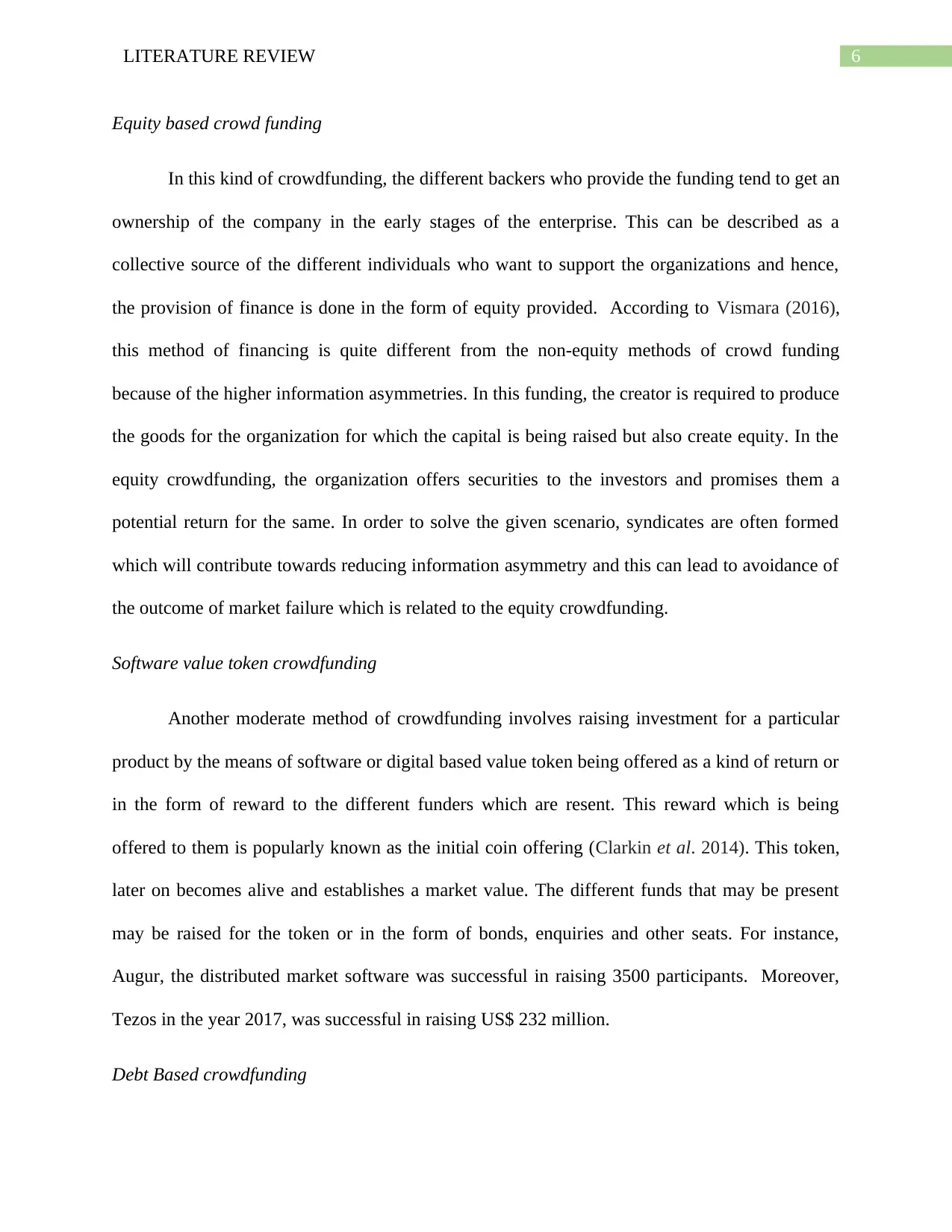
6LITERATURE REVIEW
Equity based crowd funding
In this kind of crowdfunding, the different backers who provide the funding tend to get an
ownership of the company in the early stages of the enterprise. This can be described as a
collective source of the different individuals who want to support the organizations and hence,
the provision of finance is done in the form of equity provided. According to Vismara (2016),
this method of financing is quite different from the non-equity methods of crowd funding
because of the higher information asymmetries. In this funding, the creator is required to produce
the goods for the organization for which the capital is being raised but also create equity. In the
equity crowdfunding, the organization offers securities to the investors and promises them a
potential return for the same. In order to solve the given scenario, syndicates are often formed
which will contribute towards reducing information asymmetry and this can lead to avoidance of
the outcome of market failure which is related to the equity crowdfunding.
Software value token crowdfunding
Another moderate method of crowdfunding involves raising investment for a particular
product by the means of software or digital based value token being offered as a kind of return or
in the form of reward to the different funders which are resent. This reward which is being
offered to them is popularly known as the initial coin offering (Clarkin et al. 2014). This token,
later on becomes alive and establishes a market value. The different funds that may be present
may be raised for the token or in the form of bonds, enquiries and other seats. For instance,
Augur, the distributed market software was successful in raising 3500 participants. Moreover,
Tezos in the year 2017, was successful in raising US$ 232 million.
Debt Based crowdfunding
Equity based crowd funding
In this kind of crowdfunding, the different backers who provide the funding tend to get an
ownership of the company in the early stages of the enterprise. This can be described as a
collective source of the different individuals who want to support the organizations and hence,
the provision of finance is done in the form of equity provided. According to Vismara (2016),
this method of financing is quite different from the non-equity methods of crowd funding
because of the higher information asymmetries. In this funding, the creator is required to produce
the goods for the organization for which the capital is being raised but also create equity. In the
equity crowdfunding, the organization offers securities to the investors and promises them a
potential return for the same. In order to solve the given scenario, syndicates are often formed
which will contribute towards reducing information asymmetry and this can lead to avoidance of
the outcome of market failure which is related to the equity crowdfunding.
Software value token crowdfunding
Another moderate method of crowdfunding involves raising investment for a particular
product by the means of software or digital based value token being offered as a kind of return or
in the form of reward to the different funders which are resent. This reward which is being
offered to them is popularly known as the initial coin offering (Clarkin et al. 2014). This token,
later on becomes alive and establishes a market value. The different funds that may be present
may be raised for the token or in the form of bonds, enquiries and other seats. For instance,
Augur, the distributed market software was successful in raising 3500 participants. Moreover,
Tezos in the year 2017, was successful in raising US$ 232 million.
Debt Based crowdfunding
Paraphrase This Document
Need a fresh take? Get an instant paraphrase of this document with our AI Paraphraser
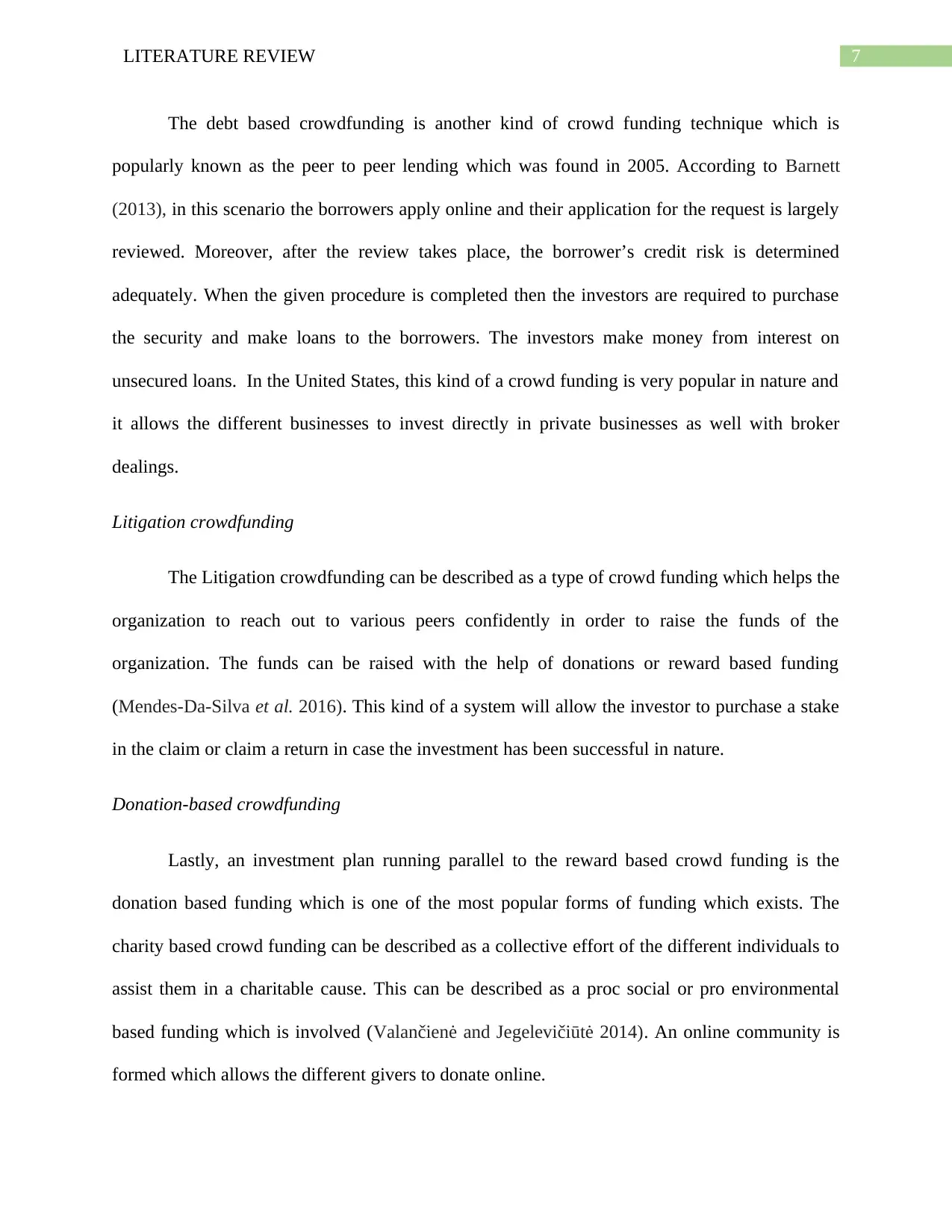
7LITERATURE REVIEW
The debt based crowdfunding is another kind of crowd funding technique which is
popularly known as the peer to peer lending which was found in 2005. According to Barnett
(2013), in this scenario the borrowers apply online and their application for the request is largely
reviewed. Moreover, after the review takes place, the borrower’s credit risk is determined
adequately. When the given procedure is completed then the investors are required to purchase
the security and make loans to the borrowers. The investors make money from interest on
unsecured loans. In the United States, this kind of a crowd funding is very popular in nature and
it allows the different businesses to invest directly in private businesses as well with broker
dealings.
Litigation crowdfunding
The Litigation crowdfunding can be described as a type of crowd funding which helps the
organization to reach out to various peers confidently in order to raise the funds of the
organization. The funds can be raised with the help of donations or reward based funding
(Mendes-Da-Silva et al. 2016). This kind of a system will allow the investor to purchase a stake
in the claim or claim a return in case the investment has been successful in nature.
Donation-based crowdfunding
Lastly, an investment plan running parallel to the reward based crowd funding is the
donation based funding which is one of the most popular forms of funding which exists. The
charity based crowd funding can be described as a collective effort of the different individuals to
assist them in a charitable cause. This can be described as a proc social or pro environmental
based funding which is involved (Valančienė and Jegelevičiūtė 2014). An online community is
formed which allows the different givers to donate online.
The debt based crowdfunding is another kind of crowd funding technique which is
popularly known as the peer to peer lending which was found in 2005. According to Barnett
(2013), in this scenario the borrowers apply online and their application for the request is largely
reviewed. Moreover, after the review takes place, the borrower’s credit risk is determined
adequately. When the given procedure is completed then the investors are required to purchase
the security and make loans to the borrowers. The investors make money from interest on
unsecured loans. In the United States, this kind of a crowd funding is very popular in nature and
it allows the different businesses to invest directly in private businesses as well with broker
dealings.
Litigation crowdfunding
The Litigation crowdfunding can be described as a type of crowd funding which helps the
organization to reach out to various peers confidently in order to raise the funds of the
organization. The funds can be raised with the help of donations or reward based funding
(Mendes-Da-Silva et al. 2016). This kind of a system will allow the investor to purchase a stake
in the claim or claim a return in case the investment has been successful in nature.
Donation-based crowdfunding
Lastly, an investment plan running parallel to the reward based crowd funding is the
donation based funding which is one of the most popular forms of funding which exists. The
charity based crowd funding can be described as a collective effort of the different individuals to
assist them in a charitable cause. This can be described as a proc social or pro environmental
based funding which is involved (Valančienė and Jegelevičiūtė 2014). An online community is
formed which allows the different givers to donate online.

8LITERATURE REVIEW
Best practices, Advantages & Disadvantages
Advantages
The advantages of the Crowdfunding has been given as follows:
Broad range of investors
According to Valančienė and Jegelevičiūtė (2014), the given procedure helps the
different investors to have an access to different types of investors and have a wider portfolio
base as well.
Combined investment in case of equity funding
In the case of equity funding, the investments as received by the company is very similar
to that a lump sum amount received in case of an IPO as received by the organization
(Manchanda and Muralidharan 2014). This makes it easier for them to invest in the organization.
Helping companies to form a rally of early investors
The reward based investments which are received go a long way in helping the
organization to form a rally of early investors who are ready to back the idea which is being
supported by the organization (Moritz and Block 2014).
Disadvantages
However, the concept of crowd funding has some disadvantages as well. These
disadvantages are given as follows:
Premature fund raise
Best practices, Advantages & Disadvantages
Advantages
The advantages of the Crowdfunding has been given as follows:
Broad range of investors
According to Valančienė and Jegelevičiūtė (2014), the given procedure helps the
different investors to have an access to different types of investors and have a wider portfolio
base as well.
Combined investment in case of equity funding
In the case of equity funding, the investments as received by the company is very similar
to that a lump sum amount received in case of an IPO as received by the organization
(Manchanda and Muralidharan 2014). This makes it easier for them to invest in the organization.
Helping companies to form a rally of early investors
The reward based investments which are received go a long way in helping the
organization to form a rally of early investors who are ready to back the idea which is being
supported by the organization (Moritz and Block 2014).
Disadvantages
However, the concept of crowd funding has some disadvantages as well. These
disadvantages are given as follows:
Premature fund raise
⊘ This is a preview!⊘
Do you want full access?
Subscribe today to unlock all pages.

Trusted by 1+ million students worldwide
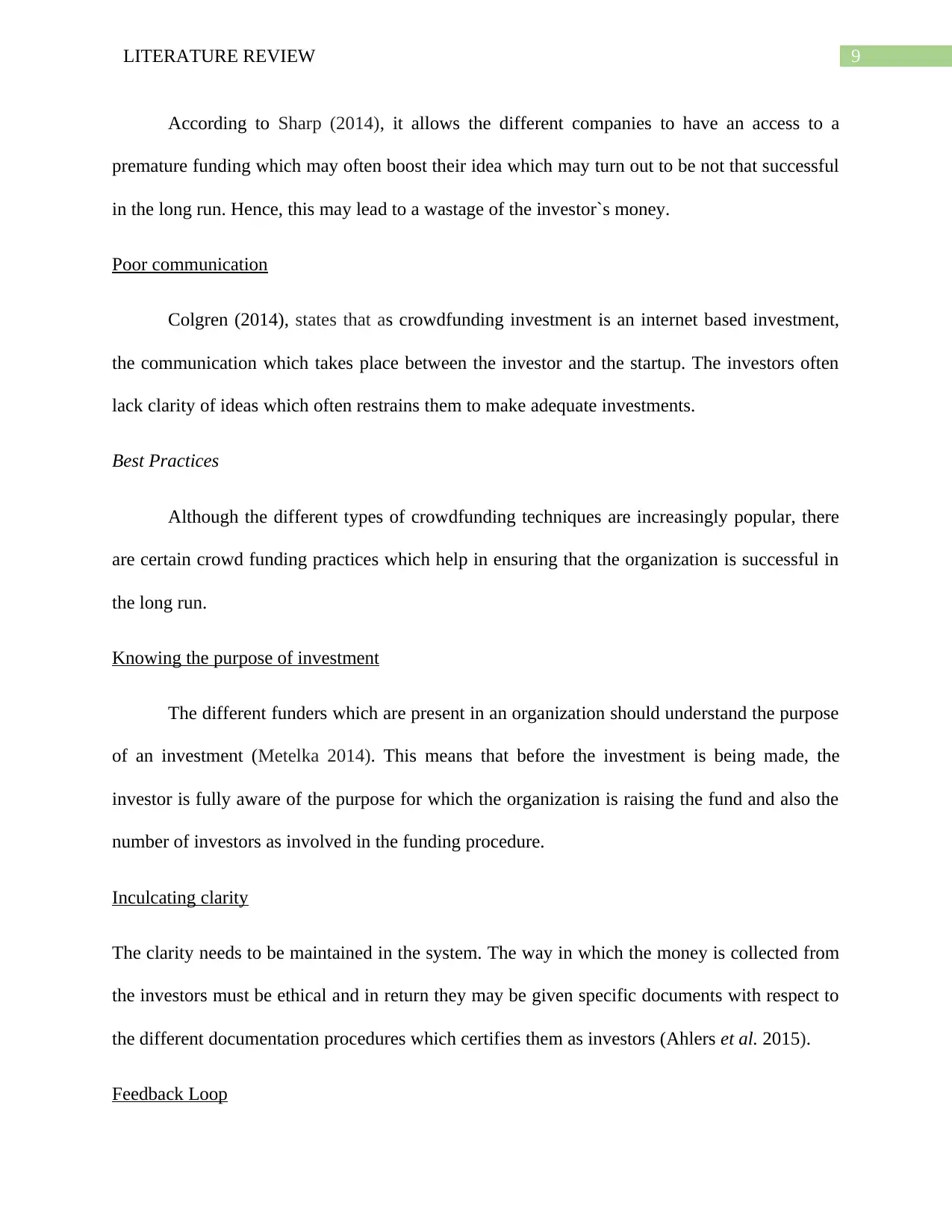
9LITERATURE REVIEW
According to Sharp (2014), it allows the different companies to have an access to a
premature funding which may often boost their idea which may turn out to be not that successful
in the long run. Hence, this may lead to a wastage of the investor`s money.
Poor communication
Colgren (2014), states that as crowdfunding investment is an internet based investment,
the communication which takes place between the investor and the startup. The investors often
lack clarity of ideas which often restrains them to make adequate investments.
Best Practices
Although the different types of crowdfunding techniques are increasingly popular, there
are certain crowd funding practices which help in ensuring that the organization is successful in
the long run.
Knowing the purpose of investment
The different funders which are present in an organization should understand the purpose
of an investment (Metelka 2014). This means that before the investment is being made, the
investor is fully aware of the purpose for which the organization is raising the fund and also the
number of investors as involved in the funding procedure.
Inculcating clarity
The clarity needs to be maintained in the system. The way in which the money is collected from
the investors must be ethical and in return they may be given specific documents with respect to
the different documentation procedures which certifies them as investors (Ahlers et al. 2015).
Feedback Loop
According to Sharp (2014), it allows the different companies to have an access to a
premature funding which may often boost their idea which may turn out to be not that successful
in the long run. Hence, this may lead to a wastage of the investor`s money.
Poor communication
Colgren (2014), states that as crowdfunding investment is an internet based investment,
the communication which takes place between the investor and the startup. The investors often
lack clarity of ideas which often restrains them to make adequate investments.
Best Practices
Although the different types of crowdfunding techniques are increasingly popular, there
are certain crowd funding practices which help in ensuring that the organization is successful in
the long run.
Knowing the purpose of investment
The different funders which are present in an organization should understand the purpose
of an investment (Metelka 2014). This means that before the investment is being made, the
investor is fully aware of the purpose for which the organization is raising the fund and also the
number of investors as involved in the funding procedure.
Inculcating clarity
The clarity needs to be maintained in the system. The way in which the money is collected from
the investors must be ethical and in return they may be given specific documents with respect to
the different documentation procedures which certifies them as investors (Ahlers et al. 2015).
Feedback Loop
Paraphrase This Document
Need a fresh take? Get an instant paraphrase of this document with our AI Paraphraser
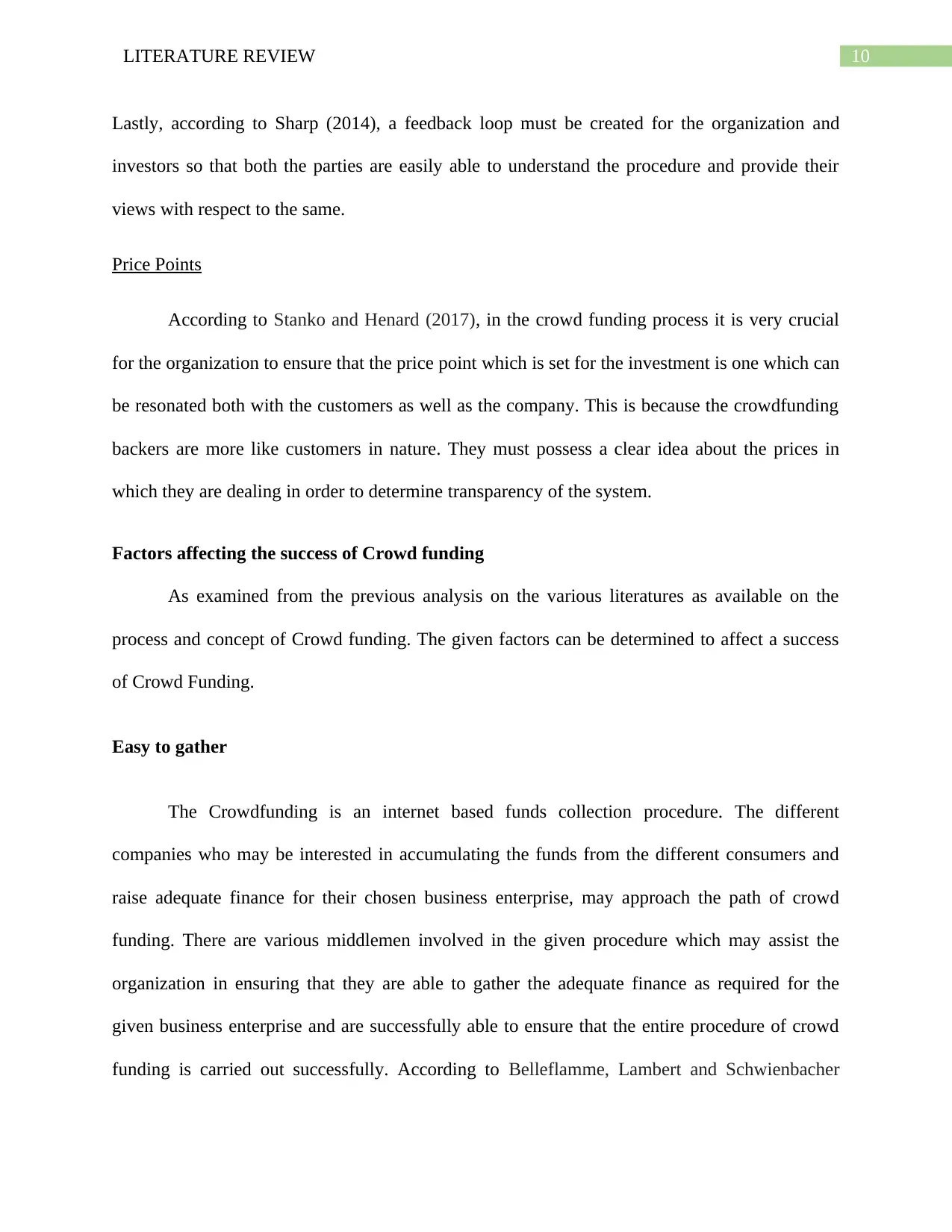
10LITERATURE REVIEW
Lastly, according to Sharp (2014), a feedback loop must be created for the organization and
investors so that both the parties are easily able to understand the procedure and provide their
views with respect to the same.
Price Points
According to Stanko and Henard (2017), in the crowd funding process it is very crucial
for the organization to ensure that the price point which is set for the investment is one which can
be resonated both with the customers as well as the company. This is because the crowdfunding
backers are more like customers in nature. They must possess a clear idea about the prices in
which they are dealing in order to determine transparency of the system.
Factors affecting the success of Crowd funding
As examined from the previous analysis on the various literatures as available on the
process and concept of Crowd funding. The given factors can be determined to affect a success
of Crowd Funding.
Easy to gather
The Crowdfunding is an internet based funds collection procedure. The different
companies who may be interested in accumulating the funds from the different consumers and
raise adequate finance for their chosen business enterprise, may approach the path of crowd
funding. There are various middlemen involved in the given procedure which may assist the
organization in ensuring that they are able to gather the adequate finance as required for the
given business enterprise and are successfully able to ensure that the entire procedure of crowd
funding is carried out successfully. According to Belleflamme, Lambert and Schwienbacher
Lastly, according to Sharp (2014), a feedback loop must be created for the organization and
investors so that both the parties are easily able to understand the procedure and provide their
views with respect to the same.
Price Points
According to Stanko and Henard (2017), in the crowd funding process it is very crucial
for the organization to ensure that the price point which is set for the investment is one which can
be resonated both with the customers as well as the company. This is because the crowdfunding
backers are more like customers in nature. They must possess a clear idea about the prices in
which they are dealing in order to determine transparency of the system.
Factors affecting the success of Crowd funding
As examined from the previous analysis on the various literatures as available on the
process and concept of Crowd funding. The given factors can be determined to affect a success
of Crowd Funding.
Easy to gather
The Crowdfunding is an internet based funds collection procedure. The different
companies who may be interested in accumulating the funds from the different consumers and
raise adequate finance for their chosen business enterprise, may approach the path of crowd
funding. There are various middlemen involved in the given procedure which may assist the
organization in ensuring that they are able to gather the adequate finance as required for the
given business enterprise and are successfully able to ensure that the entire procedure of crowd
funding is carried out successfully. According to Belleflamme, Lambert and Schwienbacher
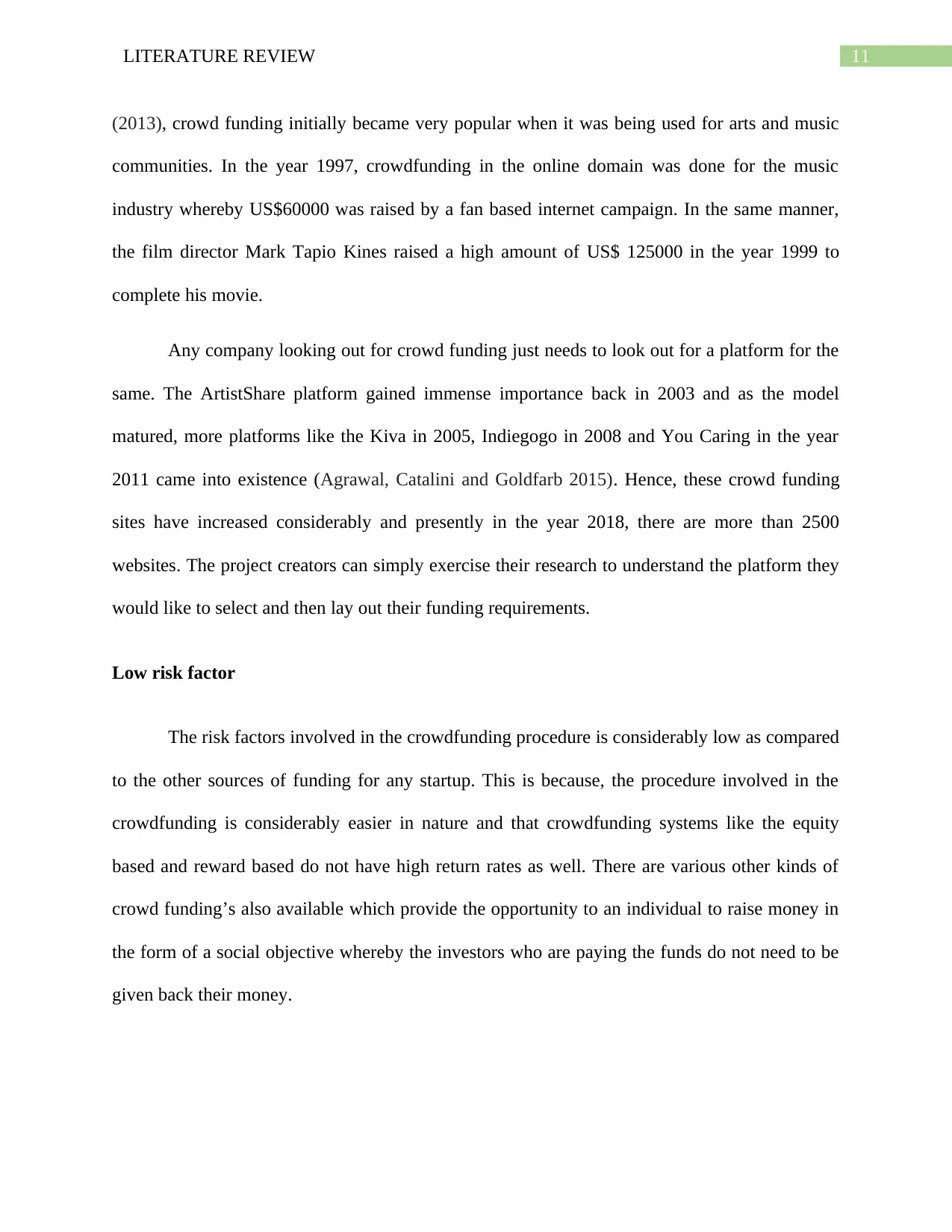
11LITERATURE REVIEW
(2013), crowd funding initially became very popular when it was being used for arts and music
communities. In the year 1997, crowdfunding in the online domain was done for the music
industry whereby US$60000 was raised by a fan based internet campaign. In the same manner,
the film director Mark Tapio Kines raised a high amount of US$ 125000 in the year 1999 to
complete his movie.
Any company looking out for crowd funding just needs to look out for a platform for the
same. The ArtistShare platform gained immense importance back in 2003 and as the model
matured, more platforms like the Kiva in 2005, Indiegogo in 2008 and You Caring in the year
2011 came into existence (Agrawal, Catalini and Goldfarb 2015). Hence, these crowd funding
sites have increased considerably and presently in the year 2018, there are more than 2500
websites. The project creators can simply exercise their research to understand the platform they
would like to select and then lay out their funding requirements.
Low risk factor
The risk factors involved in the crowdfunding procedure is considerably low as compared
to the other sources of funding for any startup. This is because, the procedure involved in the
crowdfunding is considerably easier in nature and that crowdfunding systems like the equity
based and reward based do not have high return rates as well. There are various other kinds of
crowd funding’s also available which provide the opportunity to an individual to raise money in
the form of a social objective whereby the investors who are paying the funds do not need to be
given back their money.
(2013), crowd funding initially became very popular when it was being used for arts and music
communities. In the year 1997, crowdfunding in the online domain was done for the music
industry whereby US$60000 was raised by a fan based internet campaign. In the same manner,
the film director Mark Tapio Kines raised a high amount of US$ 125000 in the year 1999 to
complete his movie.
Any company looking out for crowd funding just needs to look out for a platform for the
same. The ArtistShare platform gained immense importance back in 2003 and as the model
matured, more platforms like the Kiva in 2005, Indiegogo in 2008 and You Caring in the year
2011 came into existence (Agrawal, Catalini and Goldfarb 2015). Hence, these crowd funding
sites have increased considerably and presently in the year 2018, there are more than 2500
websites. The project creators can simply exercise their research to understand the platform they
would like to select and then lay out their funding requirements.
Low risk factor
The risk factors involved in the crowdfunding procedure is considerably low as compared
to the other sources of funding for any startup. This is because, the procedure involved in the
crowdfunding is considerably easier in nature and that crowdfunding systems like the equity
based and reward based do not have high return rates as well. There are various other kinds of
crowd funding’s also available which provide the opportunity to an individual to raise money in
the form of a social objective whereby the investors who are paying the funds do not need to be
given back their money.
⊘ This is a preview!⊘
Do you want full access?
Subscribe today to unlock all pages.

Trusted by 1+ million students worldwide
1 out of 37
Related Documents
Your All-in-One AI-Powered Toolkit for Academic Success.
+13062052269
info@desklib.com
Available 24*7 on WhatsApp / Email
![[object Object]](/_next/static/media/star-bottom.7253800d.svg)
Unlock your academic potential
Copyright © 2020–2025 A2Z Services. All Rights Reserved. Developed and managed by ZUCOL.




